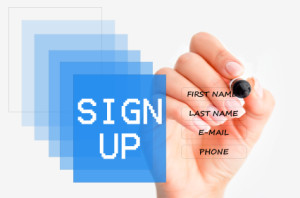
by gabriel_sales | Mar 18, 2014
 In B2B sales, we all know by now that we need to incorporate digital content into our sales processes. As a recent blog put it, “content is the fuel to our sales and marketing engine.”
In B2B sales, we all know by now that we need to incorporate digital content into our sales processes. As a recent blog put it, “content is the fuel to our sales and marketing engine.”
While content has many functions along the sales process, from lead gen to nurturing to SEO, etc., its greatest value is in helping move deals through the sales pipe to close.
In order for your content to help take buyers through the first stages of their buying journey, you need content that gets your name to the top of Google SERPs, educational content to help buyers understand your space and solution, and content that gently reminds not-yet-ready-to-buy leads of your value prop.
But to complete the journey, you need content that gives ready-to-buy prospects reasons to keep moving the deal forward.
From our experience running hundreds of outsourced sales and marketing campaigns for our clients, the three types of content we have found to be most effective in getting leads to ‘take the next step’ are:
- Checklists/Requirement Sheets
Many times in the early stages B2B content sales, prospects no close to nothing about your space or solution. Management consulting services and enterprise software solutions aren’t like iPods or toilet paper, where the general requirements are well known and risks of making the wrong decision are low. Because B2B sales are more abstract/technical and higher risk than other sales, B2B content buyers sometimes need help shopping.
Checklists and/or requirement sheets can therefore be very valuable to buyers who have never made a purchase decision in your space before. For example, in a B2B content software sale, you could offer a checklist titled, “10 Critical Features to Look for in a XYZ Software Solution” This type of content helps prospects who are nervous about buying feel more confident that your product/service will meet their needs, and they are making the most informed decision possible.
For more on B2B content continue reading the rest of this post, click here.
by gabriel_sales | Mar 12, 2014

In today’s complex world of digital marketing, web forms or lead-capture forms seem relatively simple. However, as lead capture forms are tied directly to conversion, they should not be overlooked.
Here are 6 tips for better web form conversion:
1. Don’t ask for their life story.
Asking for too many details is the number one complaint of online buyers when completing web forms. The time issue is obviously a factor here, so you need to think about how much time you are asking your prospect to spend to get what they want from you (e.g. a phone call, white paper, etc.). How much time is a white paper worth to you? Additionally, as we are in an age when privacy and information security are of paramount concern, you need to be sensitive to the fact that you are asking for details your prospects wish to remain private. Bottom line: don’t ask for anything that isn’t absolutely critical to your sales process.
2. Don’t ask for details you already have.
If you are using a marketing automation platform during your digital marketing process, at some point, you will know a few things about your prospect. If your prospects have to reenter all of their contact details and basic company information every time they want to engage with you, they will likely get annoyed. To avoid this, you can use progressive profiling (a feature of your marketing automation platform), which allows you to “set up iterative forms that enable you to designate which questions appear based on what you already know about a particular lead” (Hubspot).
3. Make autoresponses more personal.
Because of marketing automation and tools like this, we now live in a world of automation. And as we become more and more internet savvy, we are getting better at deciphering an autoresponse from a genuine human interaction. For B2B sales where emotional connection plays a larger role, the more human your company is perceived to be, the better. In terms of autoresponder emails, you can seem more human by timing the autoresponse to come a while after the form has been completed, rather than instantly. For example, if someone fills out a form at 9 p.m., have the autoresponse come the next morning, when it makes more sense for someone to be sending a business related email.
4. Trade clear value in exchange for form submission.
It is time to stop with the “fill out this form to sign up for our newsletter” requests. It doesn’t matter who your company is, a company newsletter is not valuable content. If you want people to take the time to fill out your form and trust you enough to give you their personal information, you need to offer concrete value on your end. This goes beyond just saying, “Fill out this form for our new white paper.” You need to offer the value upfront by saying something like, “Learn 10 Ways to Improve Lead Quality” or “Fill Out this Form to Learn the Value of SaaS for Compliance”. By stating the value specifically, your prospects will be much more likely to engage.
5. Use dynamic content to display different content if form completed.
Along the same lines of progressive profiling, if you already have the information you need about a prospect, you shouldn’t be asking them to fill out more web forms. You can set up your marketing automation platform to display different content (e.g. a banner ad) for prospects you already have information on.
6. Split test number of forms and number of fields.
To make sure your web forms are converting at the rate you want, you should do some basic split testing. Testing the number of forms and the number of fields can both yield insights that will help you further improve conversion rates. For instance, you may find that by taking away two extraneous fields, your conversion rate doubles. Split testing will let you know what works and what doesn’t.
For more tips on improving conversion, read 5 Tips for Building Landing Pages that Convert. Feel free to contact us with any questions.
by gabriel_sales | Mar 7, 2014

On the plains of Africa in the early days of humanity, there was no such thing as big data. We didn’t have numbers and statistics to help us determine what to do and what not to do. So, how did we learn, store and retain information about the world around us?
We used stories.
It was a story, rather than a statistic, that let us know that ‘this plant is poisonous’ and ‘that tiger will kill you’. While the world around us has changed dramatically since the time of tribal storytellers, humans still love to listen to and tell each other stories to inform, entertain and persuade.
Advertisers learned a long time ago that stories could be used as a tactic to influence buying behavior. In today’s digital marketplace where buyers are constantly bombarded with statistics and pushy sales messages, storytelling is one strategy that can help you stand out and close business.
Here are three easy ways to incorporate some basic storytelling into your content marketing strategy:
1. Plot structure
Most of us remember from elementary school that stories generally follow this structure: exposition, rising action, climax, falling action and denouement. Many of today’s great advertisements, including this year’s most popular Super Bowl Ad, also follow the classic storytelling structure.
By using this structure as the basis for your marketing content like blogs, white papers, webcasts, videos, testimonials, etc., your readers will be much more engaged with your brand. Telling a consistent story across different media channels also helps to create the trust required for closing in complex solution sales.
2. Characters
The fact that you likely know who ‘Flo’ is and what ‘the Allstate guy’ sounds like are evidence of the effectiveness of using characters in your sales and marketing messages. While it might not make sense for your business to feature a fictional character in your content marketing, you can still use voice and tone to humanize your content and give it some personality.
Another way to install characters in your marketing content is by telling your customers’ story in a creative way like Sprint did recently in a series of commercials. If you are able to tell a story where your customer is the hero, this can persuade prospects in the midst of a buying decision that they too could be a hero by making a purchase.
3. The ‘hook’
We all know the feeling of finishing a chapter in a novel or an episode in a television series—we are immensely invested in the story, then something dramatic happens and we are left with a cliffhanger. By intentionally not leaving everything on the table, you can use stories to create desire to know what happens next.
In B2B sales, creating an exciting and motivating hook is a bit more difficult, but it can be done. In a blog or video series, use the plot structure above and build some action with a few characters. Then, leave your readers hanging right before the climax and tell them when and where they can come back to find out what happens next.
For more on leveraging storytelling in your marketing content, read B2B Customers & Brands: Why Emotional Connection Matters. Feel free to contact us with any questions.
by gabriel_sales | Mar 3, 2014
 B2B professional service companies are a rare breed. The sometimes abstract nature of the service makes for a tough sale and a longer sales cycle than most. These companies therefore need all the help they can get in terms of sales and marketing, so knowing where your buyers are evaluating your services is key to a successful sales process.
B2B professional service companies are a rare breed. The sometimes abstract nature of the service makes for a tough sale and a longer sales cycle than most. These companies therefore need all the help they can get in terms of sales and marketing, so knowing where your buyers are evaluating your services is key to a successful sales process.
In a recent survey reported by MarketingProfs, it was found that the two most common places people go to evaluate professional services companies are the company’s website (81%) and search engines (63%). Beyond that, buyers ask friends or colleagues if they have heard of the company (62%), look to social media (60%) and ask a reference the company provides (56%). The survey also found that buyer used an average of 3.2 methods in their evaluation process.
While these findings are not surprising, there are several conclusions that can be drawn.
1. It makes sense for professional service firms to devote significant resources to their website and invest time in leveraging it as a sales tool.
If 81% of your buyers are heading straight to your website to evaluate your services, your website better be set up to allow them to do that. A homepage with a “sign up for our newsletter” link is no longer enough. Professional services companies’ websites need to include readily available content that:
2. Professional services firms need to use social media—if only for evaluation/vetting purposes.
B2B professional service firms are never going to be the most buzzed about thing on social media. But, if 60% of buyers look to social media in their buying process, it makes sense to at least have a presence there. The same survey found that LinkedIn is by far the most commonly used social platform during evaluation of professional services companies (70%). Twitter is only used 5% of the time and 25% of buyers check Facebook, Google or other social networks.
So, while posting constantly on Twitter might not be worth the time for professional services firms, setting up company profiles on LinkedIn, Google and Facebook is probably worthwhile. You may not need to post updates everyday, simply having an active company profile is sometimes enough to be seen as a credible, 21st century business.
3. For professional services companies to be most effective, one tactic is not enough.
With so many places to get information today, buyers are leveraging multiple resources over the course of their buying process. This suggests that to be most effective in their sales and marketing efforts, they need to leverage a variety of sales and marketing tactics to meet their buyers everywhere they are looking.
Because professional services buyers are looking an average of 3.2 places during their evaluation process, focusing only on your website—or only on SEO, or only on social media—is not enough. Professional services companies need to simultaneously work and monitor all spaces where prospects are engaging to produce the best results.
For more sales tips of B2B professional services sales, read 10 Sales Strategies for Professional Service Firms. Feel free to contact us with any questions.
by Glen Springer | Feb 26, 2014
 As a salesperson, knowing who to call and having the ability to control the conversation are key to the outcome of a call. This is where a well-run marketing automation system, content management system and lead scoring system pays off for a sales person.
As a salesperson, knowing who to call and having the ability to control the conversation are key to the outcome of a call. This is where a well-run marketing automation system, content management system and lead scoring system pays off for a sales person.
In a retail setting, it takes a keen eye and well developed senses on behalf of a salesperson to understand what customers are there to buy and who is there ‘just shopping’. The best salespeople seem to have a third eye telling them whom to approach and what tactic to use. In Malcom Gladwell’s book, The Tipping Point, he explains that these superior salesmen know that “nonverbal cues are as or more important than verbal cues” and, “subtle circumstances surrounding how we say things may matter more than what we say.”
People who are able to sell based on subtle cues are really just good at picking up buying signals early. Most salespeople just go from person to person asking, “Can I help you?”—this essentially equates to cold calling. When your organization relies on an inside sales team, you need to be like Gladwell’s superior salesperson, not an average ‘greeter’.
But, how do you do this over the phone when you can’t really interact with customers in a way that allows you to pick up all their subtle buying signals?
This has always been a problem with phone sales and cold calling. Salespeople are left wondering:
- Who’s actually interested?
- What are they interested in?
- What features are they most interested in?
- When should I call them back?
- How do I know if they really want to talk to me?
So, how do you find the answers to these questions with limited visibility?
Answer:
You see what your prospects are doing via your marketing automation system. Marketing automation gives you the ability to know who to call, which is probably the biggest success factor on a sales floor—it is what separates the best from the bunch. Marketing automation also gives you insight into when they want to hear from you, what they want to talk about, what you should share, what you shouldn’t share, etc. With a marketing automation platform, you have the information at hand to gain the respect of the prospect and have a real conversation, rather than a cold call and hearing, “No thanks, I’m just looking” or “ Who are you?” or “What is this about?”.
Another trick of great salespeople involves resources and control. Most successful sales reps know when to move on from a prospect that is not going to transact, allowing them to control when the conversation ends rather than wasting their time educating. Marketing automation can also help automate this often times tough skill by giving you the ability to see if your prospect is opening and sharing content or if he or she is just blowing smoke and is not really ready to transact.
For more on using marketing automation for sales, read “A Twist on Selecting a Marketing Automation Platform.” Feel free to contact us with any questions.
by Glen Springer | Feb 24, 2014
 It is imperative that your marketing team be data-driven. Budget dollars are tight and need to be accurately spent. Having clear data on how each of your marketing campaigns are performing is essential to being able to forecast sales, scale your campaigns/operations and re-allocate budget from low performing to high performing campaigns.
It is imperative that your marketing team be data-driven. Budget dollars are tight and need to be accurately spent. Having clear data on how each of your marketing campaigns are performing is essential to being able to forecast sales, scale your campaigns/operations and re-allocate budget from low performing to high performing campaigns.
At Gabriel Sales, our entire organization is data-driven, including the marketing team, who manages quantitative reporting and scorecards for both clients and internally. The key performance metrics we traditionally measure are the following:
- Inbound Traffic by source
- Web form conversions and inbound calls by source (Total Prospects)
- Prospects who want to talk (Sales Accepted Leads aka SALs)
- Prospects who have a project need and budget (Sales Qualified Lead aka SQLs)
- Proposals
- Closed deals
- Revenue
If you notice, we are accurately tracking the entire funnel. We do this using a combined integration of web analytics, marketing automation software, CRM software and experienced data analysts. By calculating conversion rates from previous stage (e.g. what percentage of proposals close or what percentage inbound traffic converts to web forms), we can better forecast sales and allocate spend to marketing campaigns to best enhance our marketing and sales funnel’s performance.
Additionally, with marketing automation software at the crux of our marketing and sales operations, we can see what traffic/lead conversion sources are most likely to convert to proposal and closed deals. This helps us scale those marketing campaigns that have the best conversion performance.
Lastly, we can see what sources have the poorest funnel performance and reduce or eliminate spending on those campaigns (as long as we’ve tested enough to be sure the campaign is not viable for the particular product/service we are promoting).
This level of reporting built-in to your company is no longer just a competitive advantage but is a key to sustaining and growing your business in today’s market.
For more on increasing B2B sales funnel productivity, read “The Value of Marketing Automation in the B2B Sales Process”. Feel free to contact us with any questions.



 In B2B sales, we all know by now that we need to incorporate digital content into our sales processes. As a recent blog put it, “content is the fuel to our sales and marketing engine.”
In B2B sales, we all know by now that we need to incorporate digital content into our sales processes. As a recent blog put it, “content is the fuel to our sales and marketing engine.”





